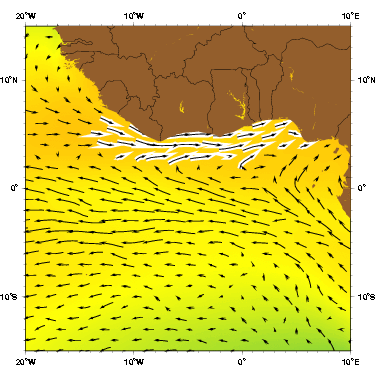
| ||
| The Guinea current as represented by the Mariano Global Surface Velocity Analysis (MGSVA). Depending on the season, the primary source waters for the Guinea Current is either the Canary Current or the N. Equatorial Counter Current (NECC). For example, during the winter, the NECC is very weak, while in the summer, the NECC is at its strongest. Click here for example plots of seasonal averages. | ||
In the mid-1600's, one of the earliest charts of global ocean circulation was produced by the Jesuit priest Athanasius Kircher in his Mundus Subteranneus. Given information from Portuguese explorers and other early natural theorists, he concluded that one of the entrances to the subterreanean channels must be located in the Gulf of Guinea in order to explain the tumultuous currents in this region (Peterson et. al., 1996).
The Guinea Current flows east at approximately 3°N along the western coast of Africa (Henin et al. 1986). When it reaches the Gulf of Guinea, it can obtain velocities close to 100 cm s-1 near 5°W (Richardson and Reverdin 1987). It has at least two sources: the North Equatorial Countercurrent (NECC) and the Canary Current. The seasonal instability of these two currents can affect the seasonal variability of the Guinea Current (Longhurst 1962, Ingham 1970). For example, during the 1983-1984 Pacific El Nino, the Intertropical Convergence Zone was far south. This led to a relaxation of the trade winds at the equator, which strengthened the NECC and, subsequently, the Guinea Current (Hisard et al. 1986, Binet 1997). In addition, Richardson and Reverdin (1987), who used buoys to investigate the Guinea Current, found that during fall and spring the buoy trajectories showed a direct connection between the NECC and the Guinea Current.
The Guinea Current, like other eastern ocean boundary currents, is characterized by areas of upwelling (Bakun 1978) and increased biological productivity (Binet 1997). Cooler waters at the surface during the boreal summer are associated with the intensification of the current (Bakun 1978, Hisard and Merle 1979, Philander 1979). The Guinea is a geostrophically balanced current with isotherms that slope upwards towards the northern coast. As the current intensifies, the slope steepens, which brings the thermocline closer to the surface near the coast. The coastal upwelling and the summer intensification of the Guinea Current are thus related (Philander 1979). However, the Guinea Current is unusual among upwelling regions in that there seems to be no correlation between sea surface temperature and wind patterns on a seasonal time scale (Longhurst 1962, Bakun 1978). According to Binet (1997), the seasonal shallowings are not induced by local wind stress, but by geostrophic adjustment of isotherms (Ingham 1970), Kelvin waves (Picaut 1983, Verstraete 1992), and cyclonic turbulent eddies (Marchal and Picaut 1997).
As stated by Colin (1988), several authors (Longhurst 1962, Boisvert 1967, Ingham 1970, Bakun 1978, and Richardson and Philander 1987) agree that the Guinea Current experiences a minimum during the winter (November through February) and a maximum during the summer (May through September). Some authors (Longhurst 1962, Boisvert 1967) thought they had detected a reversal in current direction during the minima. They attributed this change to variations in the flow of the North Equatorial Countercurrent, the Canary Current, and the Benguela Current (Longhurst 1962, Ingham 1970), and to the weakening of the easterly winds (Boisvert 1967, Ingham 1970). However, Lemasson and Rebert (1968) offered an alternative explanation. As they were studying the currents on the continental shelf of the Ivory Coast during December, they observed not only the Guinea Current, but also a current below it. This current, named the Ivoirian Undercurrent, flowed opposite to the Guinea, to the west. They also noticed that at times the speed of the Guinea Current was higher offshore than onshore. Thus, Lemasson and Rebert suggested that the presence of a westward current at the surface near the coast could be due to the surfacing of the Ivoirian Undercurrent and the seaward displacement of the Guinea Current, not due to the reversal of the Guinea Current (Colin 1988). Another explanation, proposed by Ingham (1970), is that the apparent reversals are actually caused by cyclonic eddies between the current and the coast. Ingham points out that "the data on which the concept of current reversals is based are either point observations or isolated sections perpendicular to the coastline," which do not clearly depict current reversals in the alongshore direction.